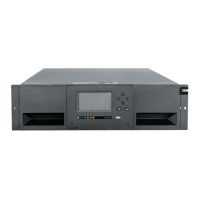Microsoft Windows application that is using the drive and storage slots of one logical library, while a UNIX
application uses the drive and slots of another logical library. See “Mixed drives” on page 13.
Multiple logical libraries
A library can be partitioned into multiple logical libraries to enable simultaneous data backup and
restore tasks from different applications. For example, you can create multiple logical libraries so that
is processes
• Commands from Application 1 (about Department A) in Logical Library 1
• Commands from Application 2 (about Department B) in Logical Library 2
• Commands from Application 3 (about Department C) using Sequential Mode in Logical Library 3
In this conguration, the tape drives and cartridges of each logical library are dedicated to that library
and are not shared among other libraries and applications. Commands that are issued by the applications
travel to the library through unique control paths or sequential mode processing by the library. So, the
data processing for Department A is conned to the tape drives and cartridges of Logical Library 1.
Processing for Department B is conned to the tape drives and cartridges of Logical Library 2, and so
forth.
For applications that do not support mixed drive types and media within the same logical library,
partitioning the library into multiple logical libraries provides the capability to keep them separate. For
example, you can partition the following tape drives and their media into multiple and separate logical
libraries:
• LTO 8
• LTO 7
• LTO 6
Multiple control paths
With this tape library's multipath architecture, in addition to creating multiple logical libraries, you can
congure any logical library to have more than one control path. A control path is a logical path into the
library through which the library receives standard SCSI Medium Changer commands to control the
library operations.
Note: No SCSI Medium Changer is congured when the logical library is enabled as Sequential Mode
Multiple control paths reduce the possibility of a failure in one control path to cause the entire library
to become unavailable. Also, when you congure more control paths, more library-sharing congurations
and options are possible. Access to the library is on a rst-come, rst-served basis. Each control path for a
logical library can accept commands while the library is in use by another control path.
Multiple control paths for control path failover
This tape library offers an optional control path failover feature. See “Library sharing” on page 23 and
“Control path failover, Data path failover, and load balancing” on page 23.
Use of the control path failover feature further reduces the possibility of a failure in one control path to
cause the entire library to become unavailable.
The control path failover feature (feature code 1682) enables the host device driver to resend a command
to a different control path for the same logical library.
Library partitioning
Libraries that contain at least two drives can congure two logical libraries. It is possible to congure up
to 21 logical libraries in the library (up to the number of drives installed).
Partitioning of libraries
With full-height or half-height physical drives, physical numbering is bottom up for all drives.
IBM Condential
72IBM TS4300 Tape Library Machine Type 3555: User's Guide

